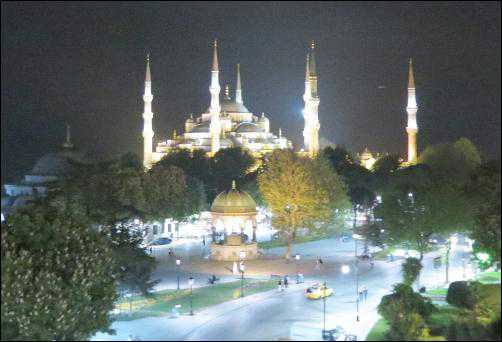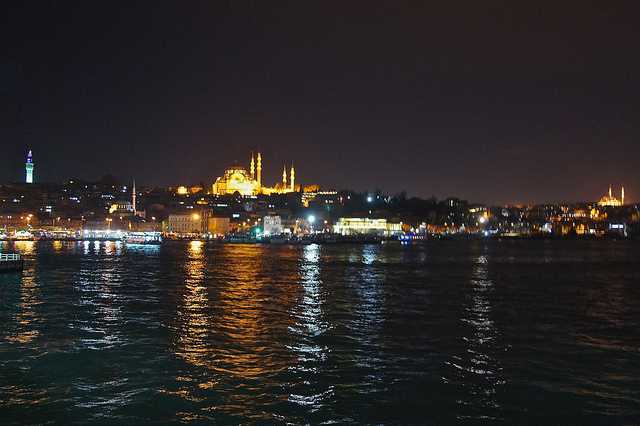 |
| Coastweek– Beautifully lit Sultanahmet Mosque also called Blue Mosque. |
.
Istanbul – City Of Many Cultures
Turks have great pride in their history and they ensure
all historical places are continuously rehabilitatedSPECIAL REPORT BY ANJUM ASODIA
.
Coastweek– Istanbul, one of the most historical cities in the world, was at one time considered the centre of the world, geographically, religiously and socially.
Starting off as Byzantium in 660BC, it was called Constantinople in 330AD and remained so for 1600 years before getting it’s new and final name.
City of many cultures from the Asians of 3000BC, Greeks and Romans from 4 BC, Ottomans from 1453AD, Istanbul served as the capital of four empires – Roman, Byzantine, Latin and finally Ottoman. About 16 million people live within just over 5,000 square kilometres making it among the most populated cities in the world, where Islam and western practises co-exist very well together.
In 2010 it was voted the tenth most popular tourist destination in the world, it’s main attraction being the historical part of the city which has been partially listed as a UNESCO world heritage site.
Luggage at Istanbul ’s Attaturk Airport has a tendency of getting on the wrong carousel. So if you have not seen your bag for a while, do not fret, but check on the eight other carousels.
|
Sultanahmet, or the old city, is made up of many hills so there is a lot of climbing up and down small narrow streets most with cobbled stones, vehicles travelling both ways despite it being just wide enough for one car. Quaint old buildings are seen literally side by side with newer ones, much like Mombasa ’s Old Town with it’s broken down houses. I stayed at the newly built Cesme Sultanahmet, ten minutes walk from the Blue Mosque and Aya Sofia. This is a small family-run establishment converted from a house to a small hotel, like most hotels in Sultanahmet. The staff, like the majority of Turks, are very friendly and most helpful even for the smallest of requests. The manager (owner’s nephew) Cengis would be there from 7a.m. to almost midnight, never seeming to sleep. Azad (Cengis’ nephew) took me by tram, and an interesting ride on the local public transport (matatus) to the Olivium Shopping Centre, good and inexpensive. The best way to see Istanbul is taking guided tours. Your tickets are bought by the tour company when you book so you do not have to queue up at the ticket counters nor at the entrance because you are let in with the group. A tour guide can also give you interesting insight of the place that you are seeing, but you have to go with everyone else’s pace. |
|
First tour was the Rustem Pasha mosque, Egyptian market, Dolmabahce Palace and Bosphorus taking up the whole day.
.
| Coastweek–One of the many shops in the Egyptian market. |
Collected from my hotel by the guide, a young lady by the name of Tuba (I loved the way she would refer to us as “dear guest” and not ladies and gentlemen – so endearing) an air conditioned bus took us to the Rustem Pasha mosque that was built in the 1500s.
Rustem Pasha was the son in law of Suleiman the Great.
|
Any mosque with one minaret means it was built by a Pasha (military commander), two minarets were built by a queen while four minarets showed that the mosque was built by the ruler and emperor. The nearby Egyptian market is one of the many that sells all kinds of spices, teas, nus and sweets. The Bosphorous cruise gave us unrestricted views of the shores of this sea. Among the many beautiful constructions on the banks are the Bisme-Alam (Queen Mother’s mosque), Dolmabahce Palace , Four Season’s Hotel (formerly a palace that was ruined by fire and restored), Ciragan Palace (Kempinsky) – the most expensive hotel in Istanbul – and Istiklal, the most crowded part of Istanbul . We sailed under the 1.074 kilometre Bosphorous Bridge which is 64 metres above the sea level, passing onto the Asian side of Istanbul . There are about seven million people living in the European part, and nine million on the Asian part but it is the former area that is more congested since space is more limited there than on the Asian side. Throughout the day and night you will see many ferries and boats criss-crossing the waters with tourists but thankfully no accidents because many years ago, after a serious pile up, a rule was decreed that all ships go one way in the morning and the other way in the afternoon. Bebek, named after a Pasha who had a baby face (hence Bebek) is one of the most expensive parts of Istanbul while the Rumeni Fort, formerly a Roman settlement, was built in 1452 in just four months. There is also a tower on a rock in the middle of the Bosphorous that was built by a king in the 12th century to ward off a prophesy that his daughter would be bitten by a snake and die in childhood. He thought that if he secluded her from the city and it’s inhabitants he could ensure that the prophesy would not come true. |
|
One day, a basket of apples carried to the rocky outcrop unknowingly had a snake in it and unfortunately the girl died.
.
| Coastweek– Beautiful mosaics that have been uncovered in Aya Sofiya. |
Back on the bus, we headed through the city passing the renown Galatasaray Football Club and the Galatasaray High School which only teaches in French.
Across the Bosphorous bridge again for lunch on the Asian side of Istanbul .
|
Golden Horn River (shaped like a horn) flows into the Bosphorous (Greek for “passage of the cow”). The other reason for this name is more mythological. Zeus fell in love with Io making his wife Hera a very jealous lady. To protect his beloved from his wife, he turned Io into a cow and she grazed her way to the Eastern side of Istanbul where she took back her human form and gave birth to a daughter, Khera (Horn). Next stop was the Dolmabahce Palace, so named because it was built on land reclaimed from the Bosphorous and has some very beautiful gardens which has pansies and tulips dotted all over the place (Dolma – to fill, like in a doner kebab and Bahce, pronounced ‘bache’ – garden). This magnificent piece of architecture, the largest palace in Turkey with the mono-block building at 45,000 square metres, was built by the Sultan Abdul Macid from 1840 to 1856 because he wanted a palace with European design (symmetrical) keeping in mind the important connections that Istanbul had with Europe . Costing what would buy 35 tons of gold, it housed the last six sultans. It has six hamams (bathrooms), 285 rooms and 64 corridors and a staircase with crystal columns that opens out to an atrium. Red was the colour of the Ottomans so the Imperial Counsel Room where dignitaries were received is made up of red and gold, blue the colour of felicity so all women’s rooms are blue. Even the heaters are painted gold. Chef’s would meet daily in the Harem section to discuss the menu that would feed 4,000 people daily. The highlight of the tour was the Grand Ceremonial Hall which hosted many parties. All of 2,000 square metres, it has 56 columns which had under floor heaters within them, but even that was not enough to heat up the massive room which measured 64 metres from top to bottom. The orchestra would play on the high overhead balconies which had some very interesting elephant figurines. Hanging from the ceiling that had beautiful gilt edged paintings on it is the world’s largest Bohemian chandelier. Made up of crystals, it weighs a massive 4.5 tons and was a gift from Queen Victoria of England . All 750 lamps work and is a sight to behold when they light it for you. Turks have great pride in their history and they ensure that all historical places are continuously rehabilitated keeping their many museums and palaces in almost the same condition as when built, no matter which era. You can only enter the Dolmabahce Palace with a plastic bag covering each shoe. Their love for gardens can be seen in the beautiful flowers and plants amid the well-kept and very clean streets of Istanbul . My second tour was also a full day trip, this time with another young lady Gunesh (sun) to the Blue Mosque, Hagia Sophia, Hippodrome and the Topkapi Palace, all within walking distance of each other in Sultanahmet (old part of the city). Sultanahmet Mosque was built in the 17th Century by Sultan Ahmet the first, taking seven years to build. That was the time when the centre of Islam had moved to Istanbul and to show his might, Sultan Ahmet decided to build a mosque with six minarets, something that was unheard of, the norm being four. It is an imposing structure with one main central dome surrounded by eight smaller ones. Also known as the Blue Mosque because of the 20,000 beautiful hand-made tiles from Iznik, the interiors look like someone has thrown a huge carpet right across the walls. Four huge marble columns, about 40 feet in circumference, which have water outlets in the base (they are called cesme or water fountain in Turkey ) for washing, go right up to the ceiling. There are more than 2,000 mosques in Istanbul , the most magnificent being the Blue Mosque and the Sulemaniye mosque (unfortunately did not get a chance to visit). Many of these mosques date back to the 1400’d but are still very much in use, the Blue Mosque being one of them. Praying in it was an awesome experience as was my chance to pray in another small mosque (Akbiyik) that was built in 1453. Hagia Sophia Museum is the third institution in the same place. Constantine the Great’s son built a wooden church in 365 BC which was burnt down in 404 AD. Roman Emperor Theodosus rebuilt it and it was named Hagia Sophia (Holy Wisdom). When Constantinople became the centre of Christianity a stronger and bigger structure was built on the spot, making it the biggest church for a thousand years. In the sixth century, there were three Romes (centres of Christianity) – Rome , Moscow and Constantinople . |
|
For 916 years the faithful would pray in this Church until Sultan Mehmet converted it into a mosque in the 15th century.



























